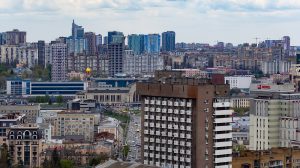Steady growth masks a wide range of problems for the Romanian economy, such as delayed reform and the EU’s highest rate of inflation.
On paper, things look good for Romania. Economic growth, limited to just over two per cent in 2023, looks set to rebound in 2024 to around three per cent. The country is politically stable and while not supporting neighbouring Ukraine with the fervour and commitment (and money) of the Baltic states, it has allowed Kyiv to reroute much of its grain exports through the port of Constanța.
Nevertheless, ahead of European and local elections that take place this weekend, on the streets of the country’s towns and cities, there is an underlying feeling that real progress has been sacrificed on the altar of stability.
- The indisputable benefits of EU membership
- Much of emerging Europe is falling behind on its commitment to equality
- Governments that are reluctant to embrace climate objectives place the energy transition in jeopardy
The current coalition arrangement between the country’s two largest political parties, the Social Democrats (PSD) and the Liberals (PNL), has stifled any attempt at genuine reform of a bloated public sector, the inefficient justice system, the failing education system, and has halted the process of digitalisation. Poor road and rail infrastructure hampers trade. The parties are running on a joint ticket in the European Parliament election and will likely do so in the country’s own parliamentary vote in December.
An underperforming economy
In brief, as well as Romania is unquestionably doing, it is underperforming; its potential is going unfulfilled.
Even its growth forecasts for 2024 are full of caveats. The European Union forecasts growth of 3.3 per cent, but this optimism is tempered by the International Monetary Fund, which forecasts a growth rate of 2.8 per cent. Most forecasts place growth estimates at around (or just under) three per cent, rising slightly in 2025.
The Vienna Institute for International Economic Studies (wiiw), which estimates growth of three per cent in its latest economic forecast for the Central and Eastern European region, notes that bullish household demand will be hampered by sluggish foreign demand and the slow arrival of EU funds.
The political landscape in Romania adds further layers of complexity to the economic forecast. Romanians will vote five times in 2024—firstly, this weekend, in European and local elections, and then in parliamentary and two rounds of presidential voting later in the year.
The current, largely ineffective president, Klaus Iohannis, cannot run for a third term. But as 2024 nears its midpoint, there is still no clear favourite to replace him. Both Prime Minister Marcel Ciolacu (PSD) and his predecessor and coalition partner Nicolae Ciucă has made it clear that they both want the job. Tensions between the pair could threaten the stability of the coalition as the September presidential vote nears.
A possible compromise candidate might be Mircea Geoană, deputy secretary general of NATO. Despite not yet officially announcing his intention to stand for president, Geoană regularly tops polls (including a poll published this week), well ahead of both Ciolacu and Ciucă.
Elections prevent fiscal consolidation
The busy electoral calendar has made badly needed fiscal consolidation and structural reforms difficult to achieve, with political parties more focused on campaigning than on governing. “Fiscal austerity will not be implemented in the current election year,” notes wiiw.
Moreover, Romania’s fiscal position remains weak, leaving the country vulnerable to external shocks. The structural budget deficit is well above sustainable levels, and while efforts to improve expenditure efficiency and tax collection are needed, the path to fiscal health is fraught with challenges. The current account deficit, projected to narrow moderately to around six per cent of GDP, remains a concern.
Fiscal consolidation would also contribute to supporting restrictive monetary policy by reducing demand pressures at a time of high inflation. The country has the EU’s highest rate of inflation, which, although falling, remained at just under six per cent in April, more than double the inflation rate in the euro area (2.4 per cent).
A 12 per cent hike in the minimum wage, announced this week (suspiciously close to the elections), is unlikely to help.
According to the Organisation for Economic Co-operation and Development (OECD), which published a survey of the Romanian economy last month, high levels of investment will nevertheless support the economy together with recovering external demand, while cost pressures on households will gradually ease.
The OECD also notes that higher pension ages will mitigate fiscal pressure from population ageing. However, government revenues remain too limited to fund emerging spending priorities. A digital tax administration is needed to tackle evasion and lift tax revenues. Other priorities are to shift more goods and services onto Romania’s standard value-added tax rate and eliminate distortive and unfair income tax expenditures.
The labour force needs more female participation
One of the key recommendations made by the OECD is the need to bring more women into the workforce.
Labour force participation has not risen enough to make up for outflows of working-age Romanians abroad, despite record levels of inward migration, primarily from South Asia.
Women remain underrepresented in the workforce, with generous parental leave encouraging mothers to step back from work to care for children. Childcare shortages also make it harder for young families to keep up two jobs, the OECD suggests.
Better availability of formal early childhood education and childcare would make it easier for parents to return to work after having children. Continued investments in teacher training and schools are also needed to improve educational outcomes, with more help better targeted to those in vulnerable communities.
A greener economy
Where Romania has seen real progress in recent years is in its transition to clean energy. A recent report from Bankwatch, a network of grassroots, environmental and human rights groups across Central and Eastern Europe, suggests that the EU’s Green Deal, and its approach of combining a lift in climate ambition with new financial and other support instruments, has started to change the perception of the CEE region as a laggard when it comes to clean energy transition. Romania (along with Latvia) is cited as a “front runner” in renewable energy deployment.
Romania saw use of fossil fuels in the power sector fall by 31 per cent from 2019 to 2023, corresponding to a 20 per cent increase in the share of renewables. Its share of renewables in power generation in 2023 was 50.4, well above the EU average of 23 per cent and above even the EU’s binding renewable energy target for 2030 (42.5 per cent).
There are still challenges, however, such as a lag in grid expansion to support increased renewable capacity. The report also notes that a lack of coherence and integrated measures in strategic documents, like Romania’s National Energy and Climate Plan, adds complexity to the transition.
Meanwhile, the weakening of environmental protection legislation, particularly concerning hydropower projects, poses a significant threat to biodiversity.
Unlike many news and information platforms, Emerging Europe is free to read, and always will be. There is no paywall here. We are independent, not affiliated with nor representing any political party or business organisation. We want the very best for emerging Europe, nothing more, nothing less. Your support will help us continue to spread the word about this amazing region.
You can contribute here. Thank you.







Add Comment